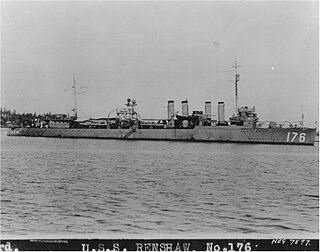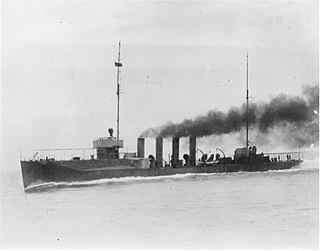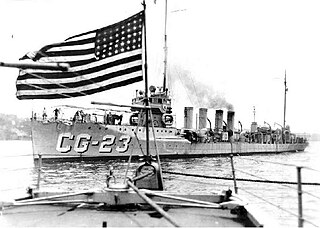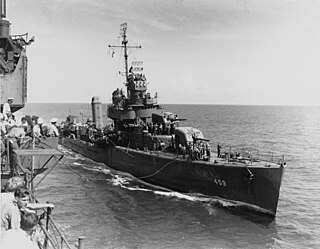
USS Radford (DD-446), named for Rear Admiral William Radford, was a Fletcher-class destroyer in the United States Navy. Entering service in 1942 during World War II the ship also saw action during the Korean War and the Vietnam War. The ship was removed from service in 1969 and sold for scrap in 1970.

The first USS Abbot (DD-184) was a Wickes-class destroyer in the service of the United States Navy until traded to Britain at the beginning of World War II. She served in the Royal Navy as HMS Charlestown (I21), a Town-class destroyer.

USS Johnston (DD-557) was a Fletcher-class destroyer built for the United States Navy during World War II. She was named after Lieutenant John V. Johnston, an officer of the US Navy during the American Civil War.

The second USS Renshaw (DD–176) was a Wickes-class destroyer in the United States Navy following World War I. She was named for William B. Renshaw.
Three ships of the United States Navy have borne the name USS Hoel in honor of William R. Hoel, a naval officer in the American Civil War:

USS Hayler (DD-997) was a Spruance-class destroyer that served in the United States Navy from 1983 to 2003. Named for Vice Admiral Robert W. Hayler (1891–1980), she was the last ship of her class.

The O'Brien class of destroyers was a class of six ships designed by and built for the United States Navy shortly before the United States entered World War I. The O'Brien class was the third of five classes of destroyers that were known as the "thousand tonners", because they were the first U.S. destroyers over 1,000 long tons (1,016 t) displacement.

The Tucker class of destroyers was a ship class of six ships designed by and built for the United States Navy shortly before the United States entered World War I. The Tucker class was the fourth of five classes of destroyers that were known as the "thousand tonners", because they were the first U.S. destroyers over 1,000 long tons (1,016 t) displacement.

The Benson class was a class of destroyers of the U.S. Navy built 1939–1943. The thirty 1,620-ton Benson-class destroyers were built in two groups. The first six were authorized in fiscal year 1938 (FY38) and laid down at Bethlehem Steel, Quincy, Massachusetts, and three naval shipyards. The remaining 24 "repeat Bensons" were authorized in 1940–42 and built at four Bethlehem Steel yards. They were laid down after the first group was commissioned. These plus the "repeat Livermores" were also known at the time as the Bristol class. During World War II the Bensons were usually combined with the Livermores as the Benson-Livermore class; this persisted in references until at least the 1960s. In some references both classes are combined and called the Benson class. The Benson- and Gleaves-class destroyers were the backbone of the pre-war Neutrality Patrols and brought the action to the enemy by participating in every major campaign of the war.

The Gridley-class destroyers were a class of four 1500-ton destroyers in the United States Navy. They were part of a series of USN destroyers limited to 1,500 tons standard displacement by the London Naval Treaty and built in the 1930s. The first two ships were laid down on 3 June 1935 and commissioned in 1937. The second two were laid down in March 1936 and commissioned in 1938. Based on the preceding Mahan-class destroyers with somewhat different machinery, they had the same hull but had only a single stack and mounted sixteen 21 inch (533 mm) torpedo tubes, an increase of four. To compensate for the increased torpedo armament weight, the gun armament was slightly reduced from five 5"/38 caliber guns (127 mm) to four. USS Maury (DD-401) made the highest trial speed ever recorded for a United States Navy destroyer, 42.8 knots. All four ships served extensively in World War II, notably in the Solomon Islands and the Battle of the Philippine Sea, with Maury receiving a Presidential Unit Citation.

USS Richard P. Leary (DD-664) was a Fletcher-class destroyer of the United States Navy. In 1959, the ship was transferred to the Japanese Maritime Self-Defense Force and renamed Yūgure. The destroyer remained in service with the Japanese until 1974, when she was returned to the US, who then sold the ship for scrap in 1976.

USS Laffey (DD-459) was a Benson-class destroyer of the United States Navy during World War II. She was the first destroyer named for Bartlett Laffey.
USS Lansdale (DD-766) was scheduled to be a Gearing-class destroyer in the United States Navy. She was named for Philip Lansdale (1858-1899), a United States Navy officer.

USS Seymour D. Owens (DD-767) was scheduled to be a Gearing-class destroyer in the United States Navy. She was named for Seymour D. Owens, a United States Navy officer killed during World War II.

This list catalogs the most honored US Naval vessels of the Second World War. It is placed in descending order of earned Battle Stars; descending accorded unit recognitions; descending ship size by type; and ascending hull number. It contains only vessels that earned fifteen or more Battle Stars for World War II service.
USS Watson (DD-482) was a United States Navy destroyer which was never laid down, her construction contract being cancelled in 1946.
USS Castle (DD-720) was a planned United States Navy Gearing-class destroyer laid down during World War II but never completed. It was to be named for Guy W. S. Castle (1879–1919), a United States Navy officer and Medal of Honor recipient.

USS Abner Read (DD-769) was a planned United States Navy Gearing-class destroyer laid down during World War II but never completed. The ship was to be the second ship named for Abner Read (1821–1863), a United States Navy officer killed during the American Civil War. She was assigned the name during construction when the first Abner Read (DD-526), a Fletcher-class destroyer, was sunk by a kamikaze during the Battle of Leyte, 1 November 1944.
USS Harold J. Ellison (DE-545) was a proposed World War II United States Navy John C. Butler-class destroyer escort that was never completed.

USS Pavlic (APD-70) was built by Dravo Corporation at Pittsburgh, Pennsylvania as a Buckley-class destroyer escort. Pavlic was launched 18 December 1943 and towed to Texas for refitting as a United States Navy high-speed transport. Pavlic was in commission from 1944 to 1946, serving in the Okinawa campaign as a radar picket ship. Pavlic was decommissioned 15 November 1946. After more than 20 years of inactivity in reserve, she was stricken from the Navy List on 1 April 1967. On 1 July 1968, she was sold for scrapping to North American Smelting Company.














